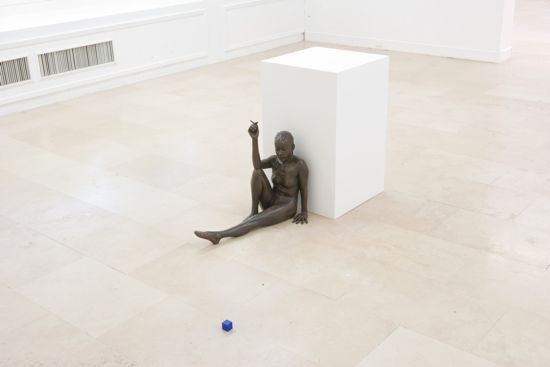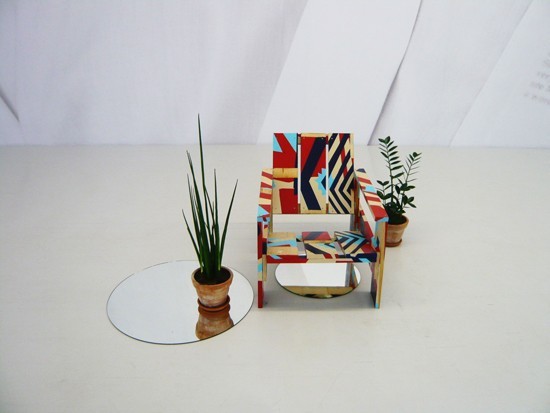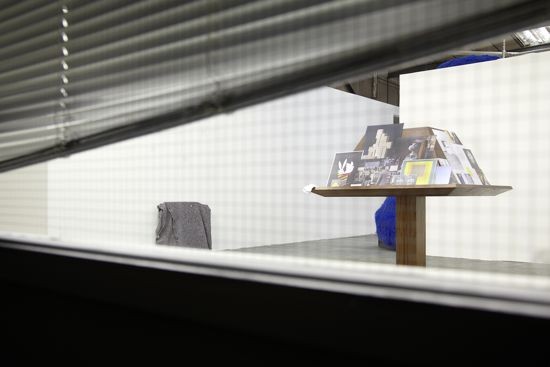IV. Quod petis, hic est

I don’t blame you, or, When we made love you used to cry and I love you like the stars above and I’ll love you like the stars above and I’ll love you ‘til I die (2008). Image Jean Brasille, © Ryan Gander, courtesy the artist.
ART iT: Going back to fiction and imagination, what can you say with fiction?
RG: You can say anything, everything. You can say words that don’t even exist.
ART iT: Do you ever find yourself getting lost in the fiction?
RG: I dream about it a lot, which is worrying. It’s disconcerting to wake up and realize you’ve been dreaming about people who don’t even exist. But fiction has to be quite real in me before I can do it. I have to spend a lot of time convincing myself. It’s like if you have a secret, and you tell a lie about that secret, and then tell that lie long enough that you believe it’s true, and forget the truth of the secret.
ART iT: How do you conceive your audience, or do you even take that step? Or, through conceiving multiple characters, are you your own audience?
RG: The person I’m addressing changes with each work. Just as there are three different ways of titling a work, there are three ways of making a work: there is the work that you make for your own pleasure, the work that addresses a specific person, and the work that’s addressed to all people.
I try to change everything every time, not just the physical form or scale of a work but also the way it’s made, which is why I often make things that people might not think of as art, like necklaces or tracksuits or children’s books or a bar or a book of cocktails. They’re all art, but they’re all other things as well. It’s really great being an artist because if you want something to exist you can make it, and there’s a reason for it to exist. You can make a Rietveld desk for your house and it’s an artwork, or you can make a necklace with a logo on it for your daughter, and it’s art; you can redesign the uniforms that the drivethru attendants wear at McDonalds if you wanted, and it could be art. You can do anything.
ART iT: If at the beginning I used the word responsibility, perhaps at this point we could use the word ethics. Is there an ethics to having that freedom, or is the only guide to what you do a matter of limitation in terms of what you are able to imagine or not?
RG: You can’t be ethical about fiction, because it’s not real. I could make a work in which Hitler is a good guy, and that wouldn’t be ethical.
ART iT: But you could have an ethos, in terms of how you apply your fiction, whether you think of it as a self-imposed constraint or as a direction toward which you are constantly moving.
RG: Well, I think the ethos is to challenge and to move and to remain light on your feet, to not be weighted down with what everyone else seems to be weighted down by: I am a painter, I am a Scottish artist, I am a woman, I am black. Those things are not important. They’re certainly nothing to do with art. I am many different people. I am a lesbian and I am black and I am in a wheelchair and I am Scottish all at once, because I am many different people!

Styling out of fatigue – Georgia, (age 8) (2011), oil on canvas, pine wood, acrylic paint, mirrors, plants, approx 80 x 150 x 150 cm. Installation view at Johnen Galerie, Berlin, photo ART iT.
ART iT: Certainly in addition to issues of identity there are many artists working with Modernism, for example – going back through the history, reinventing it, quoting it – and sometimes you feel that this history is another kind of weight or incapacitation for them.
RG: If we were to sit down and go through books of artists and identify 20 who make work about the history of Modernism, there are probably only two who really make work about the history of Modernism. The other 18 just quote the aesthetic and have nothing to do with the truth of Modernism, which is its role and its ethos in the world and the way that it changed the world, not the way it looked. Too many artists make work that’s black and red with diagonal lines because it looks like the cover of a Kraftwerk album. They’re not making work about Rodchenko or where these ideas come from, they’re just quoting a look or a style because they want to be associated with it.
There are hundreds of artists who use 16mm film, but hardly any of them make work that conceptually needs to be a 16mm film – I mean, video is better, there’s no argument. Those artists are only after sentimental value, which is manipulative, or they want to be associated with conceptual artists from the 1960s, and those are two ridiculous motivations that don’t add any value or interest to the work. A medium should be chosen because of the message or content of the work. If you’re making a work about the history of the moving image, then maybe it makes sense to use 16mm.
ART iT: But I think another reason historical subjects and references are attractive is because it gives artists a sense that they can see the system.
RG: Yes. It’s almost an attempt at validating to the spectator that they can see the system and understand it, although I don’t think they do. It’s one thing to understand an aesthetic, and understand that it is reminiscent of Hermès or of wealthy people or that it’s beautiful, but it’s very different to understand everything about it, all it’s formal qualities, it’s mystical powers. You only truly understand what an object is when you look at it from every perspective and ask a thousand questions about it. You could ask someone to think of just one question to ask about a glass, and they might not come up with anything, when there are thousands of questions to be asked, and every one has an answer that is important to the understanding of it as an object.
ART iT: Do you think we overestimate our ability to see the system? Do we overestimate our posteriority to Modernism, as well as other possible systems and subjects?
RG: Yes. Ikea is closer to Modernism than the last Venice Biennale – that’s what’s weird. Everyone has the furniture in their homes. These pieces stack up, they’re easy to clean, they can be broken down for easy storage. That’s Modernism, not just some angles and bright colors. Those are just illustrations of what we think Modernism is, because we think it’s cool. But Modernism isn’t that, it’s the everyday. It’s the point that we got to that makes it easier to live.
ART iT: Are you proposing a way of stepping outside the systems that you manipulate?
RG: That’s a good question. It’s easy to talk about what exists, but providing an alternative is really difficult. It would be good if I could.

Locked Room Scenario (2011), installation view. Image Julian Abrams, © Ryan Gander, courtesy the artist and Art Angel, London.
ART iT: So to rephrase an earlier question, if we highlight a part of the system, what happens?
RG: It’s good to see where it is in the fabric of everything, and understand where it comes from. It’s not that I propose it as a way of life, but I have noticed that if you train your ability to look at things from several perspectives at once, it’s like being on a treasure hunt of the world: you can engage the world more fully.
ART iT: How much faith do you have in your own awareness of yourself?
RG: The thing about having the objective of making work that is about change is that putting yourself in positions you haven’t been before is a really good thing, because then you make work differently. I often do things that aren’t works but are more like exercises. I make character development books – which is also how bad writers develop characters for their novels. Or, for example, when I heard about Anish Kapoor’s sculptural commission for the London Olympics, and the massive amount of money he received for the project, I set myself the task of making my own proposal, not to actually send in, but as an exercise to think through how I would use such a budget and such a platform. It’s the same with the Fourth Plinth at Trafalgar Square. And sometimes when I see a nice space – it doesn’t matter where, it could be a police station waiting room – I set aside 20 minutes to sit down with a piece of paper and imagine what I would do with that space and think about the social issues of that space. Or I invent dinners, and then invent the plates for the dinners to go on. These exercises keep you thinking and put you in a different mental space each time you do them, and they also put you a step closer to realizing the things that you actually want to make.
Return to Index
Ryan Gander: Mobilis in Mobili
